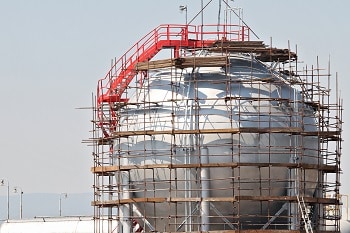The Relevance of Expert Tank Welding Inspection Solutions
The Relevance of Expert Tank Welding Inspection Solutions
Blog Article
A Comprehensive Overview of Container Welding Assessment Standards and Methodologies for Improved Weld High Quality and Efficiency
The significance of welding assessment standards in the manufacturing of containers can not be overstated, as they act as the backbone for guaranteeing weld honesty and functional reliability. Different examination techniques, including aesthetic analyses and advanced non-destructive screening techniques, are crucial in recognizing prospective defects that might endanger efficiency. Moreover, adhering to regulatory criteria not only boosts weld high quality however additionally minimizes the risk of costly failures. As we explore the nuances of these techniques, it comes to be crucial to consider exactly how an organized technique can reinvent present methods and cause substantial enhancements in end results.
Relevance of Welding Assessment Criteria

Welding inspection requirements incorporate a series of standards, including product specifications, welding treatments, and qualifications of personnel associated with the welding procedure. By imposing these standards, companies can systematically determine and fix prospective issues, thus minimizing the likelihood of expensive repair services or tragic failings. Extensive inspection techniques foster a society of responsibility and accuracy, encouraging welders to maintain high levels of workmanship.

Common Welding Examination Strategies


Ultrasonic Examining (UT) is an additional common technique, using high-frequency sound waves to discover inner defects that might not be noticeable on the surface. This technique is particularly reliable for recognizing spaces or inclusions within the weld steel. Magnetic Bit Evaluating (MT) is additionally extensively used, specifically for ferromagnetic products, as it exposes surface area and near-surface flaws through the application of electromagnetic fields and ferrous bits.
Additionally, Fluid Penetrant Testing (PT) spots surface-breaking issues by applying a penetrant to the weld and afterwards using a programmer to attract out the penetrant. Each of these techniques adds to a thorough evaluation strategy, making sure that welds meet the rigorous high quality criteria needed in container building.
Regulatory Requirements and Compliance
Governing requirements and conformity are vital components in making sure the safety and integrity of welded frameworks in tank building - Tank Welding Inspection. These criteria serve to develop minimum requirements for product residential or commercial properties, welding treatments, and inspection practices, thus minimizing the risk of architectural failures and improving overall performance
Trick organizations, such as the American Society of Mechanical Engineers (ASME) and the American Welding Culture (AWS), give standards that are widely embraced in the sector. Conformity with these criteria not only makes sure adherence to ideal techniques but likewise fulfills lawful and contractual obligations, guarding the passions of stakeholders.
Regulatory bodies typically mandate adherence to details codes, such as ASME Code Area IX for welding qualifications and API 650 for welded storage tanks. These codes detail needs for welding strategies, credentials of personnel, and testing methods to confirm weld stability.
Regular audits and assessments are important to keeping conformity, as they aid recognize deviations from developed standards. Non-compliance can result in significant penalties, project hold-ups, and safety and security hazards. get more Thus, a durable understanding of regulatory criteria and a commitment to conformity are extremely important in accomplishing premium and sturdy bonded container frameworks.
Non-Destructive Checking Techniques
Exactly how can the integrity of welded frameworks be guaranteed without triggering damage? Non-destructive testing (NDT) approaches supply a durable option, allowing inspectors to evaluate weld top quality without endangering the product - Tank Welding Inspection. Among the most usual NDT strategies are ultrasonic screening (UT), radiographic screening (RT), magnetic fragment screening (MT), and dye penetrant testing (PT)
Radiographic screening includes passing X-rays or gamma rays through the weld, developing images that disclose architectural defects such as fractures or spaces. This approach is very useful for analyzing the honesty of complicated welds.
Magnetic particle screening is matched for ferromagnetic materials, where magnetic fields expose surface and near-surface stoppages. Dye penetrant screening utilizes a liquid color to highlight surface-breaking defects, making it an effective approach for non-porous materials.
Each of these NDT techniques has distinctive advantages, enabling for comprehensive evaluations customized to specific materials and welding procedures. By implementing these methods, sectors can guarantee the integrity and safety of bonded structures, eventually boosting general efficiency.
Enhancing Weld Quality Through Assessment
Reliable evaluation plays a critical role in enhancing weld high quality, functioning as an essential checkpoint in the fabrication process. By recognizing prospective defects early, assessments minimize the threat of compromised structural integrity and guarantee compliance with market requirements. Using a mix of aesthetic examinations, non-destructive testing (NDT) methods, and mechanical analyses, assessors can detect concerns such as porosity, splits, and insufficient blend.
Applying a durable examination protocol not just boosts the total top quality of welds yet additionally cultivates a society of accountability among welders and fabricators. Regular training and qualification of examination employees make sure that they are furnished with the required abilities to acknowledge and directory deal with potential problems effectively. This aggressive strategy decreases rework and connected costs, inevitably adding to project performance.
Moreover, detailed documentation of inspection findings gives beneficial insights into recurring concerns, assisting in continuous renovation in welding practices. By leveraging innovative modern technologies, such as automated ultrasonic testing or electronic radiography, weld quality can be boosted with more specific examinations. To conclude, a rigorous assessment process is essential in attaining premium welds, ensuring security, reliability, and longevity in container manufacture.
Final Thought
In verdict, the application of Read Full Report strenuous storage tank welding evaluation standards and methods is essential for making certain weld integrity and efficiency. By utilizing a mix of aesthetic inspections, non-destructive screening approaches, and adherence to regulative criteria, organizations can successfully recognize and reduce prospective defects. Promoting a society of accountability amongst welders further improves the top quality of welding procedures. Ultimately, these methods add to reduced structural failures, lower fixing expenses, and enhanced functional efficiency within the market.
Report this page